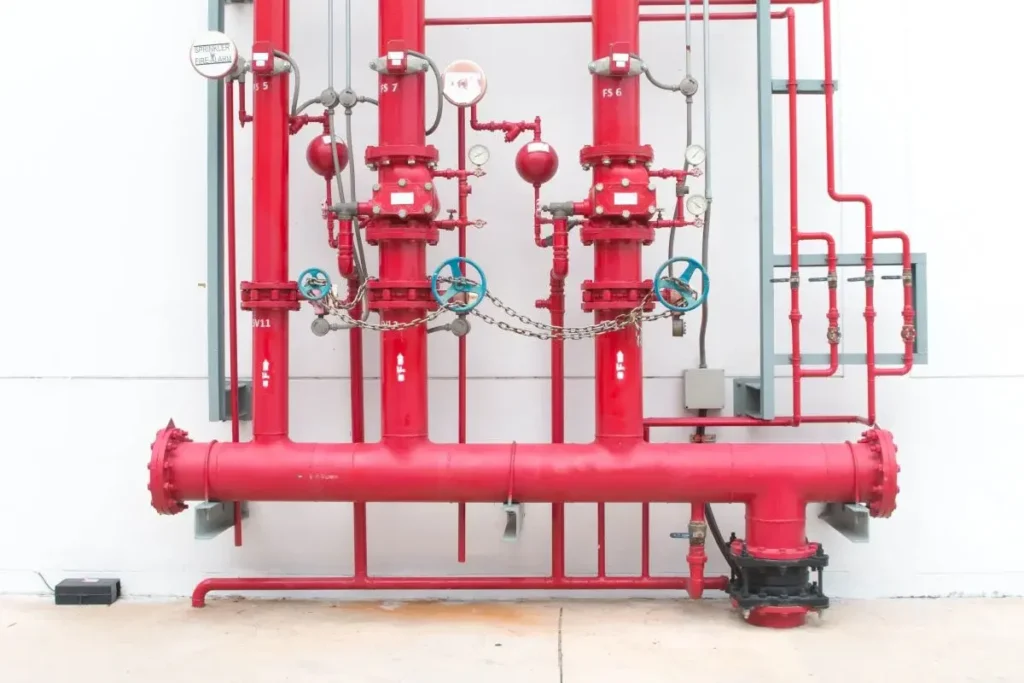Sprinkler systems are crucial components of fire prevention plans for a range of structures. Sprinkler systems function differently, although they have similar goals of containing a fire until the proper authorities arrive. The four main types are deluge, wet-pipe, pre-action, and dry-pipe systems. Below, we’ll go into greater detail about the variations. The pre-action fire sprinkler system is the primary topic of our attention.
Pre-action sprinkler system are frequently utilized in water-sensitive settings, such as data centers and museums, where water damage may result from an unintentional discharge brought on by false alarms. Other sprinkler systems are vulnerable to unintentional discharges, which could seriously harm delicate things.

WHAT IS A PRE-ACTION SPRINKLER SYSTEM?

Pre-action sprinkler system, particularly wet and dry-pipe systems, are essentially a combination of several sprinkler systems. However, it primarily employs the idea of a “dry-pipe sprinkler system,” where water is not immediately available in the piping system until it is activated by smoke or heat sensors. The electrically controlled pre-action valve’s additional detection separates the pre-action system from the dry-pipe system. In conclusion, the dry pipe can be vulnerable to an unintentional discharge while the pre-action system has additional security against it.
A pre-action sprinkler system protects against fire in structures and spaces that house objects that shouldn’t get wet. A pre-action system might be required by property owners who lease out their space or use it exclusively for their own needs. A pre-action system, for instance, has advantages for cold storage facilities, IT equipment rooms, and museums. The sprinkler system won’t be activated unless it is absolutely required thanks to the precautions built into this type of system. Simply releasing water when necessary to put out an actual fire inside the room, helps to protect the building’s contents.
HOW DOES IT WORK?
Pre-action fire sprinkler systems come in several forms. Pre-action fire sprinkler systems often have sprinklers and pipe that are comparable to ordinary fire sprinkler systems; however, the piping isn’t immediately filled with water. Only when the pre-action valve is engaged and the system encounters one or more actions does the water flow start. Pre-action sprinkler system can be of either the single interlock or double interlock variety.
SINGLE INTERLOK SYSTEM
Fire detection, such as smoke detector activation or heat warning, is necessary for the single interlock system. The pre-action valve will activate in the event of either of these occurrences, allowing water to enter the sprinkler pipes. This kind of pre-action system stops water from escaping unless there is a specific alert, and once a pre-action takes place, the system doesn’t take too long to activate.
DOUBLE INTERLOCK SYSTEM
The automatic sprinkler activation and the fire detection event are the two safeties that the double interlock system has. Water will enter the sprinkler pipes to activate the sprinklers when both circumstances take place. The double interlock system, which requires passing through two safeguards before the water is released, is an excellent idea if you want an additional layer of security to prevent erroneous fire detection. However, compared to the single interlock system, there can be a delay in reaction because it must pass through two tiers of security before the sprinklers are turned on.
A pre-action sprinkler system can be the best option if your building contains goods that require extra protection from sprinklers that activate too early. To meet the demands of the building owner, the occupants, and the contents inside, decide whether a single or double interlock system is preferable.
Where are Pre-Action Systems Typically Utilized
Pre-action systems are installed in a variety of locations where an unintentional water discharge could result in severe hardship and the destruction of property or equipment. Pre-action systems are frequently seen in the following places:
- Centres for data
- Computer and IT rooms
- Centres for Telecommunications
- Museums
- Archives
- Freezer
- Warehouses
Advantages of the Pre-action sprinkler system
- Ideally suited for water-sensitive settings like data centers, historical vaults, and laboratories
- Using a dual action to discharge water ensures that no water is released accidentally
- Prevents damage from fire and water
- Ideal for places with extreme cold since water won’t freeze in the pipes because it’s not easily retained in the piping system without the valve being opened.
Drawbacks of the Pre-action sprinkler system
- Pre-action sprinkler system require a lot of components, such as additional detection devices, making installation difficult and expensive
- Require regular upkeep
- Due to size restrictions, the system is difficult to change compared to dry-pipe systems
- There is a delay before the water is released
Installing Pre-action fire sprinkler systems in buildings
You require a system of pipes with a steady supply of water to your setup in order to build these systems. Since this system is more demanding than others, the entire setup may be complicated. Expertise in advanced sprinkler engineering is needed for the installation. Pre-action fire sprinkler systems can be designed, installed, and maintained by New York Engineers due to their considerable experience and knowledge in the field.
Building codes emphasize the value of sprinkler systems as the best safeguard against potential fire situations. Pre-action fire sprinklers should be installed in water-sensitive regions because other sprinkler systems are prone to unintentional discharges.
📢 Follow us on Instagram and Stay updated with the latest fire safety tips, equipment insights, and emergency readiness advice.
